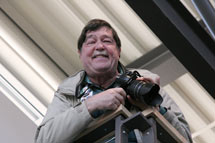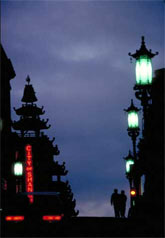
Handy Links
SLAC News Center
SLAC Today
- Subscribe
- Archives: Feb 2006-May 20, 2011
- Archives: May 23, 2011 and later
- Submit Feedback or Story Ideas
- About SLAC Today
SLAC News
Lab News
- Interactions
- Lightsources.org
- ILC NewsLine
- Int'l Science Grid This Week
- Fermilab Today
- Berkeley Lab News
- @brookhaven TODAY
- DOE Pulse
- CERN Courier
- DESY inForm
- US / LHC
SLAC Links
- Emergency
- Safety
- Policy Repository
- Site Entry Form

- Site Maps
- M & O Review
- Computing Status & Calendar
- SLAC Colloquium
- SLACspeak
- SLACspace
- SLAC Logo
- Café Menu
- Flea Market
- Web E-mail
- Marguerite Shuttle
- Discount Commuter Passes
-
Award Reporting Form
- SPIRES
- SciDoc
- Activity Groups
- Library
Stanford
Around the Bay
People: Jim Stanfield Has an Eye for Framing Things
Mechanical designer Jim Stanfield's fingerprints can be seen all over SLAC: over the past 25 years, he has helped to devise some of the klystron and beamline components, magnets, vacuum chambers and other custom components that keep SLAC science running.
But he also takes this creative, prolific impulse outside SLAC's fences, exploring the United States and Europe to snap beautiful, visually interesting photographs. He even has a photography book in the works—titled Looking for Pictures.
Stanfield fell in love with photography around the age of three, when he discovered his father's old Kodak box camera. While an engineering student at the University of Michigan, he took photography classes. From there, he just kept taking pictures—even dabbling in professional photography on occasion—but he decided to keep his passion in the recreational category.
"I wanted a more secure livelihood," he said. "It was more enjoyable to keep photography as a hobby."
Stanfield, who lives in San Francisco, portrays the city as a "wonderful place for photography." Some images in his collection include the Twin Peaks draped in morning fog, Chinatown glittering at night and seagulls along the bay. From perusing his own backyard to exploring the world-renowned sights in the city, he sees the opportunity for a lovely picture in nearly everything.
"There are pictures all around us," he said. "Just keep your eyes open."
Yosemite National Park, with its snow-frosted mountains and statuesque waterfalls, ranks high on his list of places to photograph. But he's also done extensive traveling in pursuit of his hobby, wandering around England, Scotland, France, the Netherlands, Turkey, Greece and Italy in search of striking scenes. Pictures from his Paris trip range from the Eiffel Tower at night, dotted with glowing lights, to pedestrians hiding under a cherry red umbrella.
With one foot planted firmly in engineering and the other in art, Stanfield sees where the two fields blend and where they diverge. Conceptually, he seeks out the ways in which objects relate to each other, be it in mechanical design or in a picture.
"Just key into abstract relationships," he said. "That goes for photography and how things work. But to make a good picture, it has to have a visual quality beyond how it works."
Stanfield has simple advice for amateur photographers: stop putting a picture's point of interest in the center of the frame. Size up the background, and examine the contrast between object and background.
"Don't stop considering what else is in the frame," he said.
—Julie Karceski
SLAC Today, April 7, 2010

